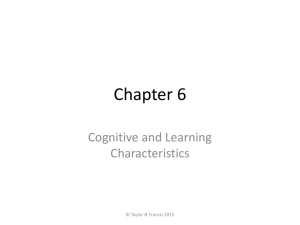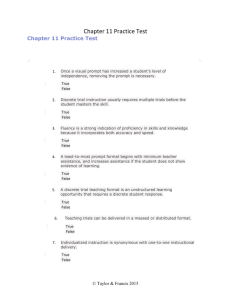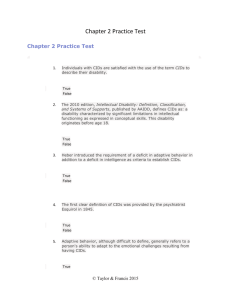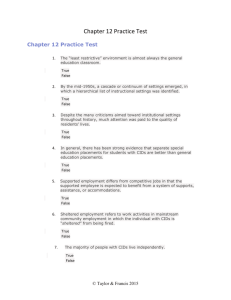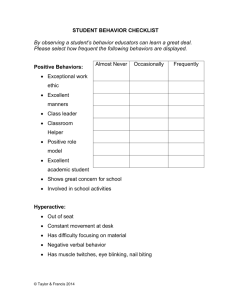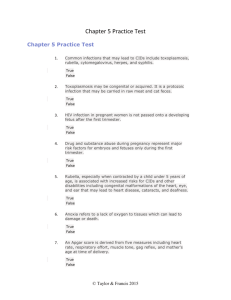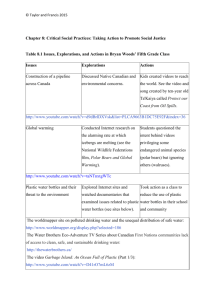Educational, Psychological, and Behavioral
advertisement
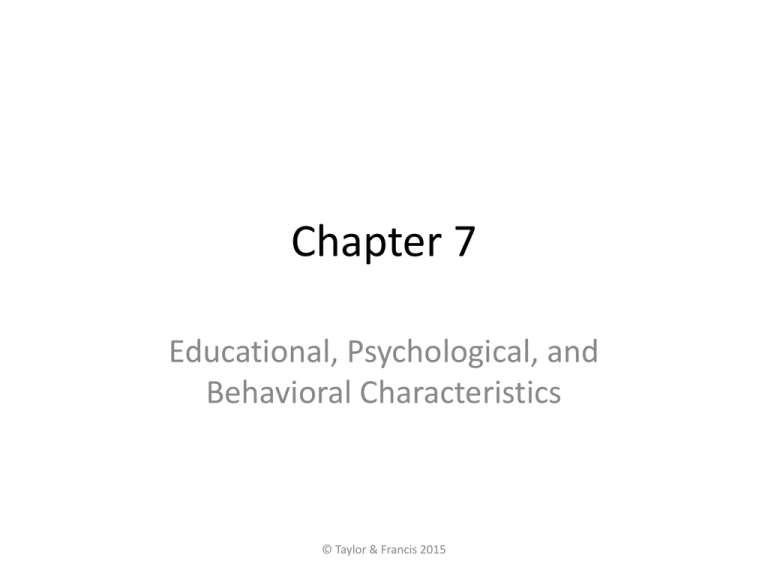
Chapter 7 Educational, Psychological, and Behavioral Characteristics © Taylor & Francis 2015 EDUCATIONAL CHARACTERISTICS • Characteristics Related to Academic Skills – Under IDEA, students with disabilities should have access to the general education curriculum even if they exhibit deficits in academic skills, but they may also need access to a functional curriculum over time. • Conceptual Thinking • Concepts are categories used to group objects, events, and characteristics on the basis of common properties. • The more exemplars children with intellectual disabilities are exposed to, the better they may be able to abstract the prototypical features of a concept. • Research into the ability of individuals with CIDs to categorize established that the ability existed and could be improved. © Taylor & Francis 2015 EDUCATIONAL CHARACTERISTICS • Comprehension Skills can be diminished intellectual capabilities that lead to both acquisition and performance deficits in comprehension and other areas. • Literacy comprehension skills are often deficient with mathematical computational skills less affected when applied in relation to the individual's overall abilities and disabilities; literacy instruction may be inadequate for many students. • Listening comprehension may also be a problem area. • Literacy instruction for students with CIDs may lack the breadth and depth needed to develop these skills. © Taylor & Francis 2015 EDUCATIONAL CHARACTERISTICS • Functional Skills are those skills that must be performed by others if not performed by the individual with CIDs. • Students with CIDs may require more time to achieve mastery and transfer and generalization of knowledge and skills. • Problems in reading can result in an ever-increasing gap between the achievement of an individual with CIDs and those without disabilities. • Students with severe disabilities have greater difficulty with synthesizing information and skills in an organized and useful way. • Emphasis on academic skills may address those skills needed for present and future living, working, and leisure. • Students with severe disabilities need opportunities to learn functional academic skills. © Taylor & Francis 2015 PSYCHOLOGICAL CHARACTERISTICS • PSYCHOLOGICAL CHARACTERISTICS are the presence of atypical psychological characteristics has historically led to segregation and even persecution. • Learned helplessness is an acquired tendency to give up easily or not to try when faced with new or difficult tasks. • Learned helplessness may result from repeated failure, a belief that others are in control, or from having others take care of one's needs unnecessarily. © Taylor & Francis 2015 PSYCHOLOGICAL CHARACTERISTICS • Characteristics Related to Self-Concept • Individuals with CIDs may differ in self-concept from those without CIDs in at least two ways: • Lack of ability in one area (e.g., academics) might affect self-concept in other unrelated areas (e.g., friendships). • The "ideal" self-image might include lower aspirations than those of individuals without disabilities. • Access to community living and recreational/leisure programs may positively affect self-concept. © Taylor & Francis 2015 PSYCHOLOGICAL CHARACTERISTICS • Characteristics Related to Self-Regulation – Self-regulation involves the abilities to plan and manage time, attend to and concentrate on tasks, organize information strategically, establish a productive environment, and utilize resources. • • Self-regulation is often learned from the modeling of others. Self-regulation is amenable to change; those with self-regulatory behavior view themselves as in charge of their own lives. • Characteristics Related to Locus of Control refers to placing causality for life’s outcomes and whether causality is linked to external or internal sources. • Those with an external locus of control tend to look to others for guidance and causality of outcomes. • Those with an internal locus of control tend to rely more on their own guidance and are more likely to assume personal responsibility for outcomes. © Taylor & Francis 2015 PSYCHOLOGICAL CHARACTERISTICS • Characteristics Related to Locus of Control (continued) • People with CIDs, like all of us, tend to fluctuate between having an external and internal locus of control, depending on the situation. • The study of locus of control and internal and external motivation lacks generality and precision, making definitive judgments about these characteristics problematic. © Taylor & Francis 2015 PSYCHOLOGICAL CHARACTERISTICS • Characteristics Related to Self-Determination and Self-Direction – Concerns an individual’s ability to set goals, plan how to reach goals, monitor progress toward goals, and adjust plans accordingly. • People with CIDs tend to stress a need for greater control in their own lives yet experience fewer options for choice-making and self-determination. • Self-determined individuals act according to their own preferences, interests, and abilities. • Becoming self-determined results from the ability to make choices and decisions. • As communication abilities decrease, deficits in being able to express one’s thoughts, feelings, and needs may inhibit selfdetermination. • Restrictive environments may limit opportunities for choicemaking and self-determination. © Taylor & Francis 2015 PSYCHOLOGICAL CHARACTERISTICS • Characteristics Related to Self-Determination – selfdetermination refers to the belief that one is accomplishing goals as a result of one’s own efforts and motivation. • Self-determination is a process beginning in early childhood and continuing to adulthood. • Self-determined individuals are autonomous, selfregulated, able to make and execute a plan, psychologically empowered, and self-realized. • Self-determination may be developed in less restrictive environments. © Taylor & Francis 2015 PSYCHOLOGICAL CHARACTERISTICS • Characteristics Related to Motivation – Motivation is typically defined as an internal state that arouses, directs, and maintains one’s behavior. • Intrinsically motivated people tend to seek out and conquer challenges in pursuit of their interests and tend to rely less on external incentives. • Extrinsically motivated people tend to show greater interest in the external incentives associated with completing a task than in the nature of the task itself. • Individuals with CIDs, like all of us, tend to follow along a continuum of self-determination of being fully self-determined to fully determined by others. • Individuals with CIDs may derive less pleasure in solving difficult problems and may be less likely to select difficult or new tasks to attack. • Engaging in choice-making, challenging opportunities and activities, goal-setting, self-monitoring, self-evaluation, and problem solving encourage development of intrinsic motivation. © Taylor & Francis 2015 BEHAVIORAL CHARACTERISTICS • BEHAVIORAL CHARACTERISTICS – The presence of challenging, difficult, or dangerous behavior should result in an analysis of a person’s life experiences, current situation, personality, and health condition toward designing some intervention. • Difficult behavior can result from internal or external triggers, trauma, limited range of expression, and overlap of conditions (e.g., CIDs and mental illness), learned behaviors, mannerisms, and disease processes. © Taylor & Francis 2015 BEHAVIORAL CHARACTERISTICS • Relationship Between CIDs and Behavioral Disorders is generally accepted people with CIDs exhibit more behavioral problems than those without disabilities. • Individuals with CIDs may have behavioral needs arising from destructiveness, self-injury, sexual aggression, and other behaviors such as tantrums, wandering, substance abuse, or not following mental health treatments. • Aggression is the behavior problem most often cited when an individual is referred for mental health services. • Some behavior, such as rule-breaking and noncompliance, may be the result of difficulties in processing and retrieving information, frustration, or lack of opportunities for recreation/leisure. • The variety of potential problem behaviors is extensive but the origins of the problems are not well known. © Taylor & Francis 2015 BEHAVIORAL CHARACTERISTICS • Relationship Between CIDs and Behavioral Disorders (continued) • Dual diagnosis results from the presence of mental illness with CIDs and is not easily identified. • Stressors that affect behavioral characteristics include transitional phases, environmental stressors, parenting and social support problems, illness or disability, stigmatization, and frustration. • Most individuals with dual diagnosis have mild to moderate CIDs. © Taylor & Francis 2015 BEHAVIORAL CHARACTERISTICS • Destructive or Aggressive Behavior may be indicated by screaming, crying, damaging property, attacking others, as well as noncompliance. • Impulse control and bipolar disorder may be more closely associated with aggressive behavior. • Self-injury was associated with more severe CIDs. • Self-Injurious Behavior includes behavior that results in harm to the individual and includes such behavior as hitting one’s head, falling intentionally, biting, gouging, and scratching oneself. • SIB tends to occur more frequently among those with severe levels of CIDs. • SIB and stereotypy might emerge in early childhood and persist, or emerge in over- or under-stimulating conditions, or be learned behavior used to control others; it is also associated with certain syndromes. • Research indicates there have been many successful interventions used with SIB. © Taylor & Francis 2015 BEHAVIORAL CHARACTERISTICS • Stereotypic Behavior refers to repetitive behaviors that tend to be physically harmless but affect adjustment. • Those with stereotypy may exhibit lower adaptive behavior scores, have more limited expressive abilities, less understanding of others’ speech, and deficits in performing daily activities and functional skills. • The origins of stereotypy are not well understood and research does, at times, conflict (e.g., establishing the different functions of stereotypy). • Stereotypy is amenable to treatment. © Taylor & Francis 2015 BEHAVIORAL CHARACTERISTICS • Interpersonal and Sexual Relationships vary widely among people with CIDs. • Those individuals in more restrictive settings may find most relationships to be with people who are paid to interact with them. • Quality of life is connected to one’s social network. • The quality of interpersonal relationships can affect both mental and physical health. • Intellectual and physical development, behavior problems, and communication abilities can affect relationship development. • Proximity to other children does not guarantee frequent social interaction. • Sexual relationships are of concern to individuals with CIDs and caregivers. • People with CIDs are more at-risk for being sexually and physically abused. • The right to privacy for those living in residential settings may be an issue. © Taylor & Francis 2015 ADAPTIVE SKILL CHARACTERISTICS • ADAPTIVE SKILL CHARACTERISTICS may include deficits in acquisition and performance of adaptive behaviors. • It is assumed that individuals with CIDs will have significant limitations in multiple dimensions of adaptive behavior. • Characteristics Related to Leisure • Participation in leisure activities and environments fosters growth, development, and wellness. • Individuals with CIDs participate in a wide variety of leisure activities and exhibit preferences. • Individuals with more severe levels of CIDs can learn to express choices in leisure settings and activities. © Taylor & Francis 2015 ADAPTIVE SKILL CHARACTERISTICS • Characteristics Related to Work – The presence of a disability leads to a lower likelihood of being employed and to substantially lower levels of income. • The Americans with Disabilities Act (ADA) was enacted to reduce discrimination in the workplace based solely on disability and mandates employers provide reasonable accommodations. • Individuals with CIDs who work in integrated settings tend to have better job skills and live more independently, although income levels are still low. • As other areas of difficulty emerge (e.g., educational and behavioral characteristics), developing and maintaining a career becomes increasingly challenging. • Supported employment, job coaching, and mandated transition planning can aid in obtaining employment. © Taylor & Francis 2015 ADAPTIVE SKILL CHARACTERISTICS • Characteristics Related to Community – Historically, segregation from the community has occurred and still does occur. • The options and costs for living in the community vary widely although the costs are usually greater for those with more severe and multiple disabilities and for those with challenging behaviors. • Institutional settings are on the decrease in the United States. • Overall, research findings suggest positive outcomes in adaptive behavior and challenging behavior associated with integrated living arrangements. • In general, people with CIDs tend to live at home with parents longer, to be more dependent on social service systems, to be less mobile, and to be less well integrated in the workforce than are those without disabilities. • The status of adulthood is often associated in Western society with leaving home and living more independently. © Taylor & Francis 2015 ADAPTIVE SKILL CHARACTERISTICS • Characteristics Related to Self-Care and Home Living – With assistance, individuals with CIDs can improve both acquisition and performance deficits in these adaptive skill areas. • Individuals living in community settings tend to have at least as good or better adaptive behaviors than those living in institutional settings. • Individuals with severe levels of CIDs are capable of learning to meet most of their self-care needs. • The challenge for service providers is to provide needed support but still allow for maximum independence. © Taylor & Francis 2015
